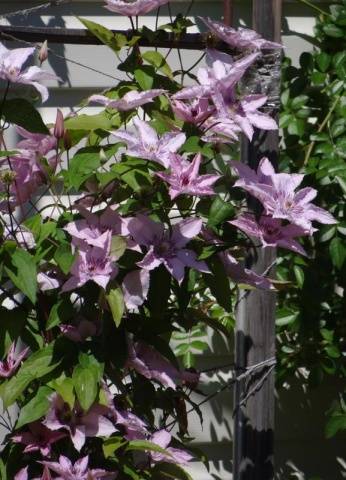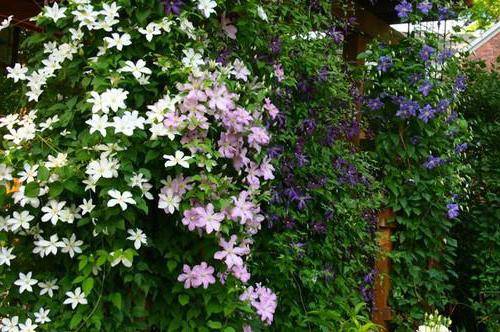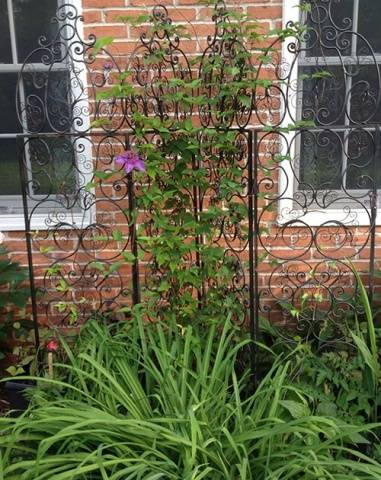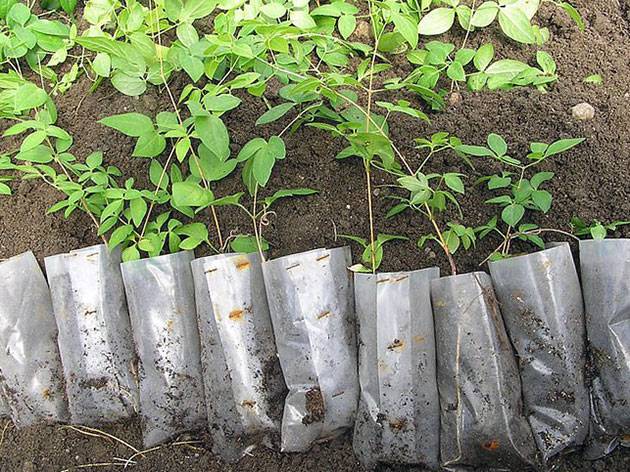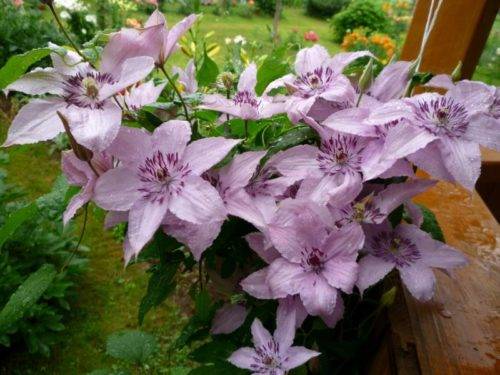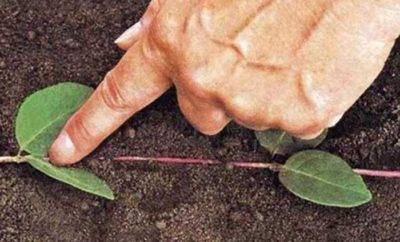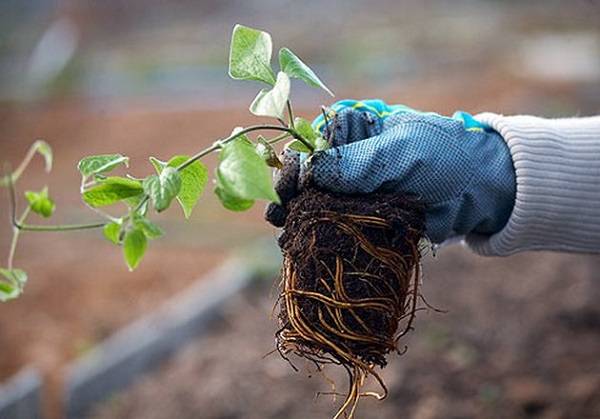Content
To create a unique landscape, many gardeners grow Clematis Hagley Hybrid (Hagley Hybrid). In the people, this plant, belonging to the genus of the Buttercup family, is called clematis or vine. Relatives of the flower grow in the wild in the subtropical forests of the Northern Hemisphere.
Description
Hagley Hybrid (Hegley Hybrid) is a product of English selection, bred in the middle of the twentieth century by Percy Picton. The Hybrid is named after its creator Pink Chiffon. A plant with amazingly beautiful flowers.
Clematis Hegley Hybrid grows slowly, but has abundant flowering, starting in July and continuing until September. The inflorescences of the hybrid have a delicate pearlescent shade of pink-lilac color. Each of the six sepals has corrugated edges. Bright brown stamens are located in the center of a large flower, up to 18 cm in diameter.
Hegley Hybrid is a vine that grows upward, climbing a support. Without this device, decorativeness is lost. Supports of various configurations will allow you to create arches or hedges with a height of 2-3 meters. The brown shoots have large juicy green leaves.
In order for Clematis Hybrid to delight the eyes with its unusual beauty, the plant must be properly cut. After all, he belongs to the third (strong) pruning group.
Landing
The tree-like liana Hybrid, according to the description, characteristics and reviews of gardeners, refers to unpretentious clematis. It does not need to be transplanted often; it grows in one place for about 30 years. When planting, you need to take into account some of the nuances.
Choosing a place and time for boarding
The decorative properties of Clematis Hegley Hybrid are clearly manifested if the right place for planting is chosen. The hybrid prefers sunny areas where there are no drafts, and an openwork shadow appears in the afternoon. The southeast and southwest sides of the site are best suited for planting.
Immediately you need to think about support. Its design depends on the gardener's imagination, the main thing is to guess with the height. The shape of the support can be any, as well as the material for it. Most often, arches, lathing or metal structures are built.
It is not recommended to plant the Hybrid Hegley directly against the wall of the house. In this case, the Hybrid can suffer from high humidity, lack of air and the attack of pests and diseases.
Hegley seedlings, a hybrid with an open root system, are planted in early spring, before the buds open, or late in the fall, after the foliage has fallen off. Summer plantings are fraught with a long survival rate, which can ultimately lead to the death of Clematis Hegley Hybrid.
Seedlings grown in planting containers with closed roots can be planted even in summer.
Selection of seedlings
Correctly selected planting material guarantees a high survival rate of clematis, and in the future, abundant flowering. If ready-made Hegley Hybrid seedlings are purchased, then you need to pay attention to the following nuances:
- long roots not less than 5 cm;
- plants without damage and signs of disease;
- the presence of two shoots with live buds;
- the seedling is at least two years old.
It is better to purchase Hegley Hybrid clematis seedlings from trusted sellers or in specialized stores.
Soil requirements
The Hegley hybrid loves light and fertile soil. Salty and heavy soils are not for our handsome man. The most suitable soil for this type of clematis is considered to be a well-fertilized sandy soil.
Ideal soil composition for clematis:
- garden land;
- sand;
- humus.
All ingredients are taken in equal proportions and mixed thoroughly. Superphosphate (150 g) and wood ash (2 handfuls) can be added.
How is landing
Although Clematis Hegley hybrid can be transplanted without sacrificing decorativeness, when planting, it must be borne in mind that it can be grown in one place for up to 30 years. Therefore, the planting pit is well filled, so that later only to feed.
Planting Clematis Hybrid in stages:
- A hole is dug 50 cm deep, the diameter depends on the size of the root system.
- Drainage from stones or crushed stone, brick fragments is laid on the bottom. The height of the drainage cushion is not less than 20 cm. A bucket of water is poured out.
- Half of the pit is filled with nutrient mixture and watered again.
- In the center, a mound is raked up, on which clematis is placed and the root system is carefully straightened. All roots should be facing down.
-
Sprinkle the clematis seedling with soil and gently slap the ground around with your palms.Attention! The root collar of the Hegley hybrid is buried 10 cm.
- After planting, clematis is shed abundantly to remove air pockets from under the roots.
- The last procedure is to tie up shoots.
Care
Clematis Hegley Hybrid belongs to unpretentious plants, so it is worth getting a vine on your site. Although some agrotechnical nuances still exist. We will talk about them.
Top dressing
The hybrid grows slowly, so feeding for it is vital throughout the growing season:
- In early spring, clematis needs nitrogen-containing fertilizers to activate the growth of the vines.
- When shoots begin to form and bud formation begins, Clematis Hegley Hybrid is fed with complex fertilizers.
- Before the end of flowering, wood ash and phosphorus-potassium fertilizers are applied under the hybrid.
Loosening and mulching
Clematis Hegley The hybrid is picky about watering. To retain moisture, the soil is loosened to a shallow depth, and mulch is added on top. It not only maintains soil moisture and reduces the need for watering, but also saves the root system from overheating.
Watering
Hegley Hybrid is a moisture-loving plant. To preserve decorativeness, the flowers are watered three times a week, 2 buckets for each liana.
Pruning
The cultivation technique of Hegley Hybrid involves heavy pruning, since the plants belong to the third group. Clematis needs rejuvenating pruning, only in this case one can hope for decorativeness and abundant flowering.
Shoots are cut annually at the age of three years. Gardeners with experience in growing clematis use three-tiered pruning. In each tier after the operation, 3-4 shoots are left, differing in age and length:
- the first tier - 100-150 cm;
- second tier - 70-90 cm;
- the third tier is cut so that only 3 buds remain from the ground.
All other shoots are cut out mercilessly.
Shelter for the winter
Before sheltering for the winter, Clematis Hegley Hybrid is treated with copper-containing preparations for fungal diseases. For this procedure, you can use a pink solution of potassium permanganate, Fundazole or vitriol. You need to water not only the shoots themselves, but also the root zone.
Clematis Hegley Hybrid belongs to the group of garden plants for which temperatures below 10 degrees are dangerous.In the southern regions, the liana winters well without shelter. But in a harsh continental climate, planting needs to be protected.
The bushes are covered with mulch from dry foliage until the first frost. Then set the box and cover it with foil. Holes are left on the sides for ventilation. The film is completely pressed to the ground only in case of severe frosts.
The preparation procedure for wintering begins before the first frost appears. First of all, you should cut off dried branches, painful and damaged. You will also need to manually remove the foliage, otherwise the flower will not look aesthetically pleasing in spring.
Particular attention should be paid to young vines, they are more vulnerable and weak.
Disease and pest control
Clematis Hegley Hybrid has its own diseases and pests that you need to know about in order to grow a healthy decorative vine.
Diseases and pests | Signs | Control measures |
Withering. | Stunted and drying shoots. The reason is a strong deepening of the root system. | The plantings are treated with copper sulfate. |
Gray rot | Brown spots on the leaves. | Preventive spraying of clematis with Hybrid Fundazol. |
Rust | Red spots on the leaves. | If the lesion is strong, remove diseased shoots. The rest of the bush is sprayed with copper sulfate or Fundazol. |
Powdery mildew |
| For processing, use a soap solution |
Spider mite | Clematis are covered with cobwebs, the flowers cannot bloom and dry up, the leaves turn yellow over time | Spray Hegley Hybrid clematis with garlic tincture. |
Nematodes | All parts of the plant are affected. | It is impossible to overcome the pest. Clematis are removed by the root. A flower can be grown at this place only after 5 years. |
Reproduction
Clematis Hybrid is propagated in different ways:
- dividing the bush;
- layering;
- cuttings.
You can only divide an adult bush, which is at least three years old. Flowering begins already in the year of planting. How to do it correctly can be seen in the photo.
To obtain a new bush in the spring, a young shoot is taken away, bent down and covered with earth with a layer of at least 15 cm. To prevent the branch from rising, it is fixed with a bracket. A year later, the bush is planted in a permanent place.
Reproduction of Clematis Hegley Hybrid cuttings - one of the common methods. Cuttings with two knots can be taken after pruning. They are soaked in water with a growth stimulator for 18-24 hours, then placed in a nutrient medium. Rooting is completed in 6 months. The plant is ready to plant.
Application in landscape design
The beauty and decorativeness of Clematis Hegley Hybrid is hard not to appreciate: https://www.youtube.com/watch?v=w5BwbG9hei4
Landscape designers give clematis a special role. Liana is planted in separate bushes or combined with other garden plants. Hedges, arches or hedges braided with liana look colorful.
Conclusion
It is not difficult to grow unpretentious clematis if you know agricultural techniques. At first, questions may arise, but the grown flowers will delight you with large beautiful flowers, help create unusual corners in the garden.
